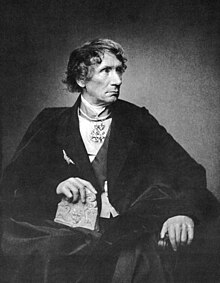Leo von Klenze




Leo von Klenze (Franz Karl Leopold von Klenze; 29 February 1784, Buchladen (Bockelah / Bocla) near Schladen – 26 January 1864, Munich) was a German neoclassicist architect, painter and writer. Court architect of Bavarian King Ludwig I, Leo von Klenze was one of the most prominent representatives of Greek revival style.
Biography
Von Klenze studied architecture and public building finance under Friedrich Gilly in Berlin, and worked as an apprentice to Charles Percier and Pierre François Léonard Fontaine in Paris. Between 1808 and 1813 he was a court architect of Jérôme Bonaparte, King of Westphalia. Later he moved to Bavaria and in 1816 began to work as court architect of Ludwig I.[1] The King's passion for Hellenism shaped the architectural style of von Klenze. He built many neoclassical buildings in Munich, including the Ruhmeshalle and Monopteros temple. On Königsplatz he designed probably the best known modern Hellenistic architectural ensemble. Near Regensburg he built the Walhalla temple, named after Valhalla, the home of gods in Norse mythology.
When Greece won its independence, Ludwig I's son Otto became the country's first king. Von Klenze was invited to Athens to submit plans of city reconstruction in the style of Ancient Greece. Russian Emperor Nicholas I commissioned von Klenze in 1838 to design a building for the New Hermitage, a public museum that housed the Romanov collection of antiquities, paintings, coins and medals, cameos, prints and drawings, and books. Prior to this, von Klenze had also designed and arranged museum galleries in Munich, including the Glyptothek, Ludwig I's museum for antique sculpture, and the Alte Pinakothek, a painting gallery for the pictures of the Wittelsbach collection.
Von Klenze was not only an architect, but also an accomplished painter and draughtsman.[2] In many of his paintings ancient buildings were depicted. Those served as models for his own architectural projects. Klenze studied ancient architecture during his travels to Italy and Greece. He also participated in excavations of ancient buildings in Athens and submitted proposals for the restoration of the Acropolis.
Klenze collected works of important contemporary German painters. He sold his collection, including 58 landscapes and genre paintings, to King Ludwig I in 1841. These paintings form the core of the Neue Pinakothek museum's collection.
Von Klenze married Maria Felicitas Blangini (1790–1844) a beauty at the court of Ludwig I.[3] Their granddaughter Irene Athenais von Klenze became Countess Courten (1850–1916).
Von Klenze died in 1864 and was buried in the Alter Südfriedhof in Munich.
Architectural works
- In Munich (München):
- Glyptothek (1816–1830)
- Alte Pinakothek (1826–1836)
- Residenz – Königsbau, Festsaalbau and the Allerheiligen-Hofkirche (1826–1842)
- Monopteros temple in Englischer Garten (1836)
- Propyläen Gate (1846–1862)
- Ruhmeshalle (1850)
- Monopteros in the park of Nymphenburg Palace
- Ludwigstrasse, Odeonsplatz and adjacent Wittelsbacherplatz
- Ballhouse in Wilhelmshöhe castle park, (Kassel) (1809–1810)
- Ismaning castle (1816) built for a stepson of Napoleon, Eugène de Beauharnais, and his spouse.
- Walhalla temple near Regensburg (1816–1842)
- Neues Schloss (New Palace) at Pappenheim (1819–1820)
- New Hermitage in Saint Petersburg, Russia (1839–1852)
- Catholic church of St. Dionysios the Areopagite in Athens, Greece (1853–1865)
- Befreiungshalle in Kelheim (1863)
See also
References
 Media related to Leo von Klenze at Wikimedia Commons
Media related to Leo von Klenze at Wikimedia Commons- Friedrich Pecht (1882), "Klenze, Leo von", Allgemeine Deutsche Biographie (in German), vol. 16, Leipzig: Duncker & Humblot, pp. 162–166
- ^ "Leo von Klenze". Oxford Reference.
- ^ "Leo von Klenze". Getty Museum. Archived from the original on 9 May 2013. Retrieved 30 March 2013.
- ^ "Nobel jewels" (PDF). Sothebys.
Further reading
- Buttlar, Adrian von (1999). Leo von Klenze: Leben – Werk – Vision (in German). München: Verlag C.H.Beck. ISBN 3-406-45315-5. OCLC 43903895.
- Freitag, Wolfgang M., ed. (1997) [1985]. Art Books: A Basic Bibliography of Monographs on Artists (2nd ed.). New York, London: Garland Publishing. p. 202. ISBN 0-8240-3326-4. OCLC 959084737 – via Google Books.
- Hederer, Oswald (1964). Leo von Klenze, Persönlichkeit und Werk (in German). München: Callwey. OCLC 557795976.
- Lieb, Norbert; Hufnagl, Florian (1979). Leo von Klenze, Gemälde und Zeichnungen (in German). München: Callwey. ISBN 3-7667-0457-5. OCLC 6109933.
- Wiegmann, Rudolf (1839). Der Ritter Leo von Klenze und unserer Kunst. Düsseldorf: Schreiner. OCLC 44657025 – via the Internet Archive.
- Architects of the Bavarian court
- 19th-century German architects
- 19th-century German painters
- German male painters
- German neoclassical painters
- Greek Revival architects
- Members of the Bavarian Maximilian Order for Science and Art
- Recipients of the Pour le Mérite (civil class)
- Neoclassical architects
- Recipients of the Royal Gold Medal
- 1784 births
- 1864 deaths
- Burials at the Alter Südfriedhof
- People from Wolfenbüttel (district)
- Leo von Klenze buildings
